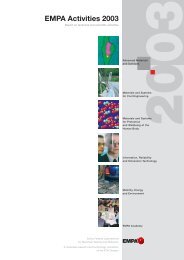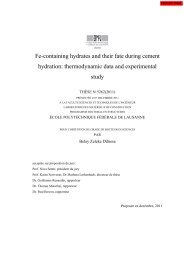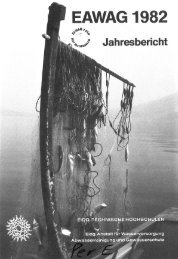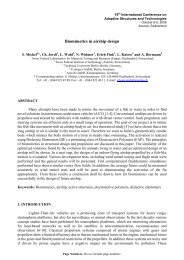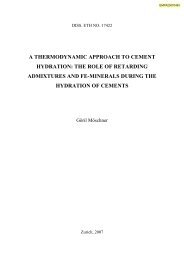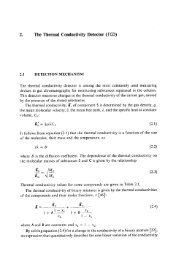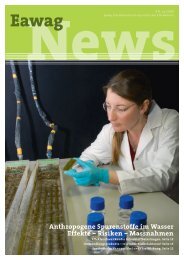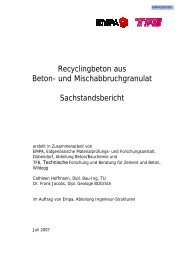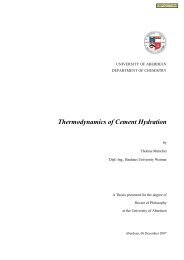Entire volume - Eawag
Entire volume - Eawag
Entire volume - Eawag
Create successful ePaper yourself
Turn your PDF publications into a flip-book with our unique Google optimized e-Paper software.
mean breadth of about 50 km, and contains<br />
no less than 20% of all liquid fresh water<br />
on the surface of the planet. The lake is<br />
estimated to be over 25 million years old,<br />
has the highest biodiversity of any lake now<br />
existing, and supports a unique ecological<br />
system with about 1500 floral and more than<br />
3500 faunal species and subspecies.<br />
Lake Baikal is frozen over during 4 to 5<br />
months of the year, but because of the difference<br />
in climate along the lake, there is a<br />
north-south gradient in both the timing of<br />
freeze-up and the timing of break-up. Freezing<br />
begins in late October, and most of<br />
the northern basin is usually frozen over by<br />
early December; the southern basin, however,<br />
does not freeze over until about a<br />
month later. Ice decay in the southern part<br />
of the lake begins in late March or early<br />
April, and by the middle of May the southern<br />
basin is generally ice-free. Break-up in the<br />
northern basin occurs 2–3 weeks later. Because<br />
of these north-south differences, ice<br />
observations on Lake Baikal can only refer<br />
to a specific part of the lake. Fortunately, the<br />
date of break-up at the same point of observation,<br />
the Listvyanka limnological station<br />
on southern Lake Baikal, has been registered<br />
continuously since 1869.<br />
Another Influencing Factor:<br />
the Annual Minimum Air<br />
Temperature<br />
As in the case of the Lej da San Murezzan,<br />
the timing of break-up of Lake Baikal correlates<br />
strongly with the local air temperature<br />
(right-hand peak in Fig. 5A). However, the<br />
existence of a further important correlation<br />
(left-hand peak in Fig. 5A) implies that the<br />
situation at Lake Baikal is more complex [5].<br />
The timing of break-up of Lake Baikal is determined<br />
not only by the air temperature<br />
prevailing during the spring thaw, but also<br />
by the minimum air temperature prevailing in<br />
February during the coldest period of the<br />
Siberian winter (Fig. 5B). The air temperature<br />
at this time of year determines the maximum<br />
thickness of the ice layer (the lower<br />
the minimum air temperature, the thicker the<br />
21 EAWAG news 58<br />
Beat Müller, EAWAG<br />
Fig. 4: In winter people and goods are transported over the ice of Lake Baikal.<br />
ice layer becomes), and also influences the<br />
thickness of the insulating snow layer (the<br />
lower the minimum air temperature, the less<br />
snow falls). Air temperatures in March, just<br />
before the snow begins to melt, normally lie<br />
below zero but above the annual minimum,<br />
and so influence neither the processes of<br />
thawing nor those of ice growth (Fig. 5B).<br />
The air temperatures prevailing in March are<br />
hence much less relevant for the timing of<br />
break-up than those prevailing in February<br />
and April.<br />
As in the case of the Lej da San Murezzan,<br />
the timing of break-up of Lake Baikal is<br />
strongly related not only to local air temperatures,<br />
but also to air temperatures<br />
measured at large distances from the lake –<br />
in this case, throughout northern Asia. This<br />
is the case especially in February and April<br />
(Fig. 6).<br />
Effect of Climate Warming<br />
on Ice Cover<br />
In a further project, we analyzed a uniquely<br />
comprehensive set of 4 decades of observations<br />
of the timing of break-up of<br />
196 Swedish lakes. These lakes are distributed<br />
along a north-south gradient, covering<br />
13 degrees of latitude [6, 7]. The analysis<br />
showed that the relationship between the<br />
timing of lake ice break-up and air temperature<br />
is nonlinear, resulting in marked differences<br />
in how the timing of lake ice break-up<br />
responds to changes in air temperature<br />
between colder and warmer geographical<br />
regions, or between colder and warmer time<br />
periods. This implies that lakes in warmer<br />
A<br />
Shared variance r 2 (%)<br />
B<br />
Mean air temperature (°C)<br />
30<br />
20<br />
20<br />
0<br />
10<br />
5<br />
0<br />
-5<br />
–10<br />
–15<br />
–20<br />
1. Maximum<br />
14 February<br />
Annual<br />
Minimum<br />
1 February<br />
p = 0.01<br />
Jan. Feb. March<br />
2. Maximum<br />
21 April<br />
0 °C<br />
17 April<br />
April<br />
May<br />
Fig. 5: (A) Proportion of variance shared (r 2 ) between<br />
the observed date of break-up at Listvyanka on southern<br />
Lake Baikal and the mean air temperature at the<br />
Babushkin meteorological station for an integrating<br />
time of 31 days.<br />
(B) Seasonal progression of the 31-day mean air temperature<br />
at Babushkin (based on data from<br />
1931–1994).<br />
The r 2 value exhibits two maxima, viz. on 14 February<br />
and 21 April (A). These two days closely follow the<br />
dates of occurrence of the annual minimum air temperature<br />
(1 February) and the intersection of the air<br />
temperature curve with the 0 °C line (17 April), respectively<br />
(B). Shaded areas represent the usual ranges of<br />
freeze-up date and break-up date of southern Lake<br />
Baikal (mean date ± one standard deviation). The p =<br />
0.01 significance level is shown as a dashed line.<br />
Adapted from [5].




